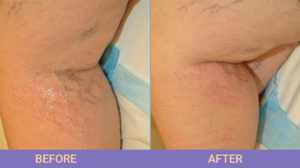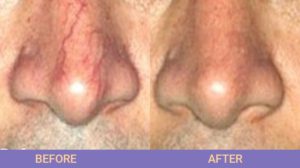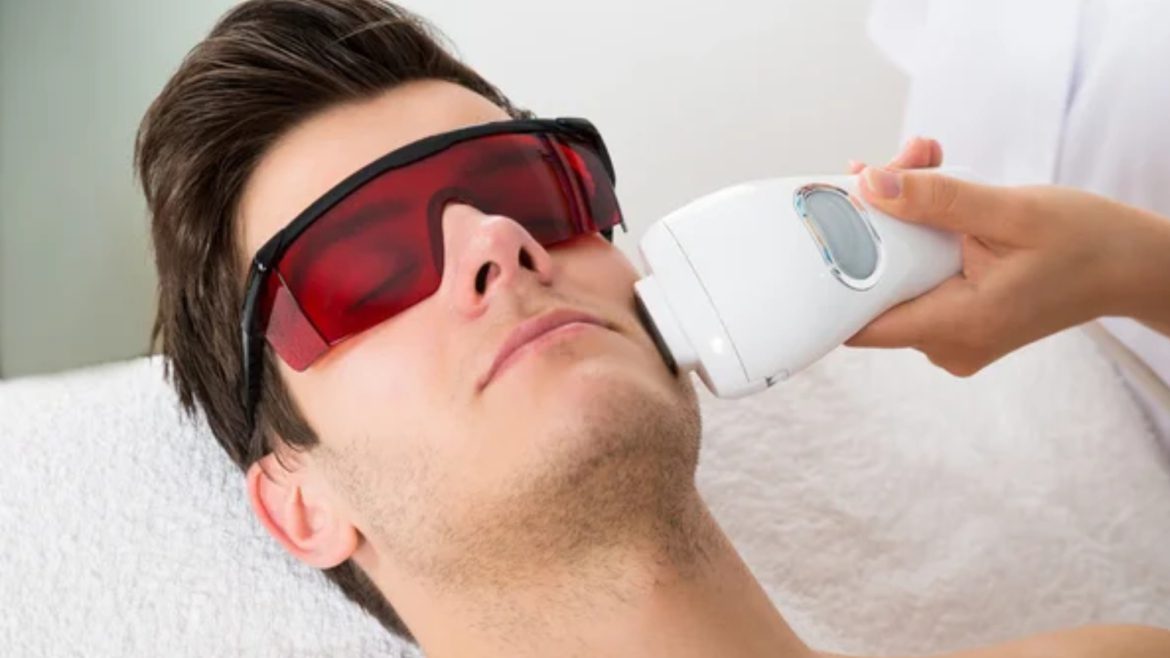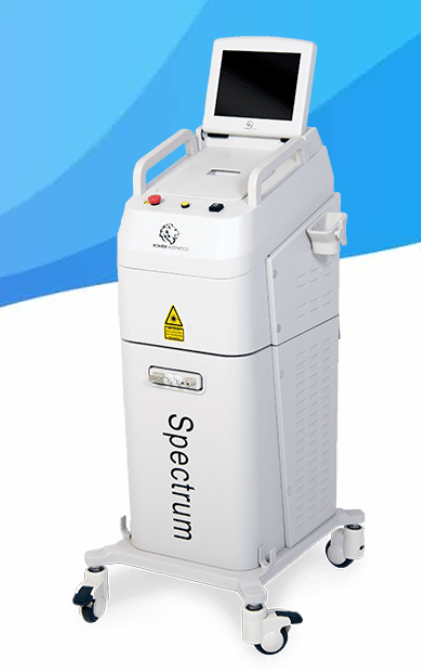IPL treatment, or Intense Pulsed Light laser treatment, is performed using a laser between 500 nm and 1200 nm wavelength. This treatment can treat various conditions, including hair removal, acne treatment, and the removal of vascular and pigmented lesions. The goal is to give a more youthful and clear skin. Four broadband filters are included in our IPL equipment at Onestop Aesthetics Travel and Wellness Center. Each filter emits incoherent radiation that is directed at specific chromophores. By nature, this treatment is non-ablative and mild.
Typical treatment areas include Face, Hands, Neck, and Chest. These issues can result from sun-damaged skin, hormonal changes or genetic vascular conditions. IPL treatment is safe for Fitzpatrick skin types 1 to 4. When we perform IPL treatment on the face, we call it IPL Photofacial.
What machine do you use for IPL treatment?
We use a Spectrum laser machine from Rohrer Aesthetics. It is an FDA-approved laser machine.
What are the typical issues addressed by IPL Treatment?
IPL treatment is a non-invasive way to address skin concerns. This treatment is also known as photorejuvenation or photofacial; this cosmetic procedure uses light pulses to target various issues. However, it’s important to remember that the success of this procedure can vary depending on factors like your skin type and the severity of the problem. Some of the conditions that can be addressed with this procedure include:
- Hyperpigmentation: IPL treatment treats hyperpigmentation issues like sunspots, age spots, and freckles. By targeting pigmented cells with light energy, IPL laser breaks them down, resulting in their gradual flaking off from the skin’s surface.
- Sun Damage: If you’re dealing with sun damage, such as sunspots and uneven skin tone due to excessive sun exposure, IPL treatment can be a highly effective solution.
- Rosacea: This treatment can effectively reduce symptoms such as redness, flushing, and visible blood vessels. The light energy specifically targets and constricts blood vessels, resulting in a significant reduction in redness.
- Acne and Acne Scarring: IPL treatment can effectively target bacteria and reduce inflammation caused by acne, promoting collagen production and improving skin texture for those with mild acne scars.
- Fine Lines and Wrinkles: Although not as powerful as lasers or dermal fillers, this laser treatment can still benefit collagen production, resulting in better skin texture and fewer fine lines and wrinkles.
- Enlarged Pores: If you’re looking for a way to refine your skin texture and reduce the appearance of pores, IPL treatment is a great option. This treatment stimulates collagen production, resulting in tighter pores and smoother skin.
- Vascular Lesions: IPL laser effectively targets visible blood vessels and vascular lesions, including broken capillaries and spider veins. By coagulating the blood within the vessels, this treatment causes them to fade over time gradually.
- Hair Removal: Hair removal is a popular application of IPL treatment. By absorbing light energy, hair follicles are damaged and prevented from further growth. We perform laser hair removal using an 810 nm diode laser hair removal machine as it is more effective for laser hair removal. You can read more about it on this page.
Who should not undergo IPL treatment?
- Avoid IPL treatment if you are expecting or nursing a child.
- Diseases that are triggered by heat or light, include Systemic Lupus, Epilepsy, and Porphyria
- Active skin problems like eczema, rash, or psoriasis are treated.
- Excessively tanned skin or recent use of tanning lotion
- Treatment for permanent cosmetics or tattoos
- Surface-level implants or metal in the treatment region
- Treatment for precancerous moles or cancer history
- Practitioner’s discretion regarding unsafe treatment or other conditions
What are the precautions I need to take post-treatment?
If you recently underwent surgery or a deep peel on the affected area, wait until the treatment area has fully healed.
After receiving Botox or natural fillers, wait one month.
If you are using any photosensitive drugs, request a spot test.
Talk to your doctor about them before considering IPL treatment if you have poorly regulated endocrine conditions like Polycystic Ovary Syndrome or diabetes. Inform the medical professional performing your treatment as well as the technician.
If keloid or hypertrophic scar history is present, less severe treatment should be used. Please inform the doctor during your consultation.
During the IPL consultation, please talk to the doctor to stop an outbreak of herpes simplex if there is a history. A prophylaxis should be initiated in the treatment area.
PRE-TREATMENT instructions for IPL treatment:
- A physician’s proper diagnosis is required before IPL treatment.
- Clean the treatment area before beginning the therapy. Makeup, creams, fragrances, and lotions should not be used in the treatment area.
- Before therapy, male patients should shave three days before the treatment (the pigment in your beard could increase discomfort).
- One month before the treatment, stop tanning in the sun, using tanning beds, and applying any sunless tanning treatments.
- Apply sunscreen with an SPF of 30 or higher to all exposed treatment areas. Wear caps and garments that shield you from the sun.
- Stop using exfoliating products one week before the treatment begins.
- If the patient has a history of herpes outbreaks in the regions being treated, a prescription drug such as Valtrex is provided for one week prior to the treatment to assist prevents an outbreak.
Post-treatment instruction for IPL treatment:
- The patient should have a moderate facial cleanser.
- The patient should have high-quality sunscreen with an SPF 30 (zinc and titanium dioxide > 10%).
- Patients should have a suitable moisturizer for aftercare.
- Patients should have a pain reliever such as ibuprofen, or acetaminophen can be used to alleviate discomfort.
- An antibiotic ointment, such as Bacitracin, can be used if an open area appears or if the treatment area is mistakenly picked.
How does IPL Treatment work?
What are the possible side effects of IPL treatment?
After IPL treatment, most patients experience minimal discomfort and heal quickly. Redness is common and can last up to a few days, but swelling is rare. Less common side effects include blistering, bruising, changes to skin color (usually short-term), and crusting. Most people have minimal discomfort and heal quickly after IPL treatment. This treatment is generally considered safe when performed by trained and experienced medical professionals like Dr Garg, who is trained in Advanced Aesthetics.
However, like any medical procedure, there are potential side effects and risks associated with this treatment. Before the procedure, being aware of these potential side effects is important. Possible side effects of this laser treatment include:
Discomfort: You may feel some mild discomfort or a snapping sensation as the light pulses target your skin. However, this sensation is usually brief and tolerable.
Redness and Swelling: It’s normal to experience some redness and mild swelling in the treated area right after the treatment. This should go away within a day or so, but it may take longer for some people.
Skin Pigmentation Changes: IPL treatment can cause temporary or permanent changes in your skin color, such as dark or light patches. This risk is higher for people with darker skin, so discuss your skin type with your provider.
Skin Damage: If the IPL device is not adjusted properly, you may develop blisters, peeling, or crusting in the treated area. This can also increase your risk of scarring or infection.
Eye Protection: The bright light in IPL laser can harm your eyes if you don’t wear protective goggles. Make sure your provider provides and instructs you on proper eye protection.
Cold Sore Reactivation: IPL treatment near your lips may trigger a recurrence if you have a history of cold sores. Be sure to inform your provider of any medical conditions or medications you take.
Aftercare: To minimize the risk of complications, follow your provider’s instructions on how to take care of your skin after the treatment. This may include avoiding sun exposure, applying soothing creams, and avoiding certain products or activities.
While IPL can offer many benefits, weighing the potential risks and benefits before deciding to proceed is important. Choose a qualified, experienced provider, ask questions, and communicate your concerns and expectations.
How do I know what Fitzpatrick skin type I have?
Before the treatment, the doctor will conduct a brief consultation to ensure it is tailored to your needs. During the consult, we will provide you with a Fitzpatrick-type determination worksheet to determine your skin type. This classification system is frequently used in dermatology and cosmetic procedures, including IPL treatments. Based on your skin’s response to sun exposure and tendency to tan or burn, the Fitzpatrick skin type classification system classifies different skin types into six categories: very fair (Type I) to very dark (Type VI).
Determining your Fitzpatrick skin type requires examining various factors. Your skin’s natural color and response to sun exposure are influenced by your genetic background. Skin type tends to run in families, so consider your family’s skin type. Pay attention to how your skin reacts to the sun to determine your skin type.
Do you burn easily and never tan (Type I or II)?
Do you burn first and then tan with difficulty (Type III)?
Do you tan easily and rarely burn (Type IV)?
Do you rarely burn and tan deeply (Type V)?
Do you have very dark skin that rarely burns (Type VI)?
Additionally, your hair and eye color can provide clues about your skin type. Individuals with lighter hair and eye colors are likelier to have lighter skin that burns easily. Freckling is also a factor, as individuals who develop freckles easily are more likely to have fairer skin types that burn rather than tan. Lastly, your tanning habits can help determine your skin type.
You may have a lower Fitzpatrick skin type if you consistently burn without tanning. By understanding your skin type, you can better protect your skin from sun damage and choose appropriate skincare products. Based on these factors, here’s a general breakdown of the six Fitzpatrick skin types:
The following is a breakdown of skin types and their associated characteristics:
Type I: Very fair skin, always burns, never tans. Typically has red or blonde hair and blue or green eyes.
Type II: Fair skin, burns easily, tans minimally. He often has fair or blonde hair and blue, green, or hazel eyes.
Type III: Light to moderate brown skin, burns initially, tans gradually. Typically has brown hair and hazel or brown eyes.
Type IV: Moderate to olive brown skin, rarely burns, tans easily. Commonly found in individuals with Mediterranean or Middle Eastern heritage.
Type V: Dark brown skin, rarely burns, tans easily and deeply. Often seen in individuals with African, Latin American, or Indian heritage.
Type VI: Very dark skin, rarely burns, tans deeply. Commonly found in individuals of African descent.
By breaking down each skin type and using cultural references, readers can easily identify their skin type and understand its prevalence in various populations. It’s important to note that this classification system is a general guideline, and variations within each skin type can occur. If you’re unsure of your Fitzpatrick skin type or have concerns regarding cosmetic procedures like IPL treatments, it’s best to consult with a qualified dermatologist or skincare professional.
What to expect during the IPL treatment?
- Consultation: Before the treatment, you’ll typically consult a qualified practitioner, such as a dermatologist or trained aesthetician. They will assess your skin type, discuss your concerns and goals, explain the procedure, and determine if IPL is the appropriate treatment for you.
- Preparation: You may be instructed to avoid sun exposure, self-tanning products, and certain skincare products for the period leading up to the treatment. This helps to ensure the procedure’s effectiveness and reduce the risk of complications.
- Cleansing: On the day of the treatment, your face will be thoroughly cleansed to remove any makeup, oils, or dirt from the skin. This allows the IPL device to work more effectively.
- Eye Protection: Your practitioner will provide protective eyewear to shield your eyes from IPL treatment light during the treatment. Safety goggles are crucial to prevent potential damage to your eyes.
- Cooling Gel: A gel-based conductive medium might be applied to your skin. This gel helps to improve the contact between the IPL device and your skin, enhances the effectiveness of the treatment, and provides a layer of comfort.
- IPL Pulses: The practitioner will then use the IPL device to deliver controlled bursts of IPL light energy onto your skin. You might feel a snapping or slight stinging sensation as the pulses are applied. The light energy targets the specific skin concern being treated, such as pigmentation, blood vessels, or hair follicles.
- Sensations: The sensations experienced during the treatment can vary depending on individual pain tolerance, the area being treated, and the settings of the IPL device. Most people find the sensations bearable, and some face areas might be more sensitive than others.
- Cooling Measures: Some IPL devices have built-in cooling mechanisms to help minimize discomfort. In other cases, a handheld cooling device or chilled air might provide relief during the procedure.
- Duration: The duration of the treatment session can vary depending on the size of the treatment area and the specific concerns being addressed. A typical session might take around 15 to 45 minutes.
- Post-Treatment Care: After the treatment, the cooling gel will be removed, and your skin will be cleaned. Your practitioner might apply a soothing cream or moisturizer to help calm the skin.
- Immediate Effects: You might notice some immediate changes, such as redness or mild swelling, which are temporary and expected reactions. These effects usually subside within a few hours to a day.
- Multiple Sessions: Depending on your skin concern and the severity of the issue, multiple IPL sessions might be recommended. These sessions are typically spaced a few weeks apart to allow your skin to heal and achieve the best results.
How do you feel after IPL laser treatment?
After treatment, your skin may appear red, but swelling is rare. You can resume your normal routine immediately and use a cooling gel pack or cold compress to soothe the skin for a few hours. Your skin may feel sensitive for a few days. If you have any issues or questions, don’t hesitate to get in touch with our office. After an IPL laser treatment on the face, many individuals experience some immediate and short-term sensations. These sensations can include:
- Mild Discomfort: During the IPL treatment, you might feel a sensation similar to snapping a rubber band against your skin. Some people describe this as uncomfortable but tolerable. Your practitioner may apply a cooling gel or use a cooling device to help alleviate any discomfort during the procedure.
- Redness: It’s common to experience temporary redness and mild swelling immediately after the treatment. This is a normal reaction and usually subsides within a few hours to a day.
- Sensitivity: Your skin may feel more sensitive to touch for a short period following the treatment. This sensitivity is usually temporary.
- Warmth or Heat: Some individuals might feel warmth or heat in the treated area. This is a normal response to the energy from the IPL device and should dissipate shortly after the treatment.
- Minor Peeling or Flaking: Depending on the specific skin concern being treated, you might notice some minor peeling or flaking of the skin in the days following the treatment. This is a part of the skin’s natural healing process.
- Avoidance of Sun Exposure: After an IPL treatment, it’s important to avoid direct sun exposure and use sunscreen to protect your skin, as it can be more sensitive to sunlight.
IPL Laser Treatment Before and After photos






After IPL treatment, most patients experience minimal discomfort and heal quickly. Redness is common and can last up to a few days, but swelling is rare. Less common side effects include blistering, bruising, changes to skin color (usually short-term), and crusting.
What other Aesthetic Services do you offer?
You can look at all the services we offer at this link.
Where can I look at all the services and prices for each? Can I book it online?
Yes. You can click the Book Online button and select MedSpa from the dropdown to look at the prices and book services online.



